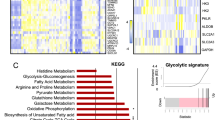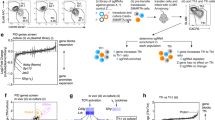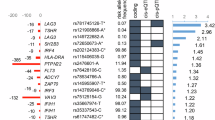Abstract
Proper cellular metabolism in T cells is critical for a productive immune response. However, when dysregulated by intrinsic or extrinsic metabolic factors, T cells may contribute to a wide spectrum of diseases, such as cancers and autoimmune diseases. However, the metabolic regulation of T cells remains incompletely understood. Here, we show that MYO1F is required for human and mouse T-cell activation after TCR stimulation and that T-cell-specific Myo1f knockout mice exhibit an increased tumor burden and attenuated EAE severity due to impaired T-cell activation in vivo. Mechanistically, after TCR stimulation, MYO1F is phosphorylated by LCK at tyrosines 607 and 634, which is critical for glyceraldehyde-3-phosphate dehydrogenase (GAPDH) acetylation at Lys84, 86 and 227 mediated by α-TAT1, which is an acetyltransferase, and these processes are important for its activation, cellular glycolysis and thus the effector function of T cells. Importantly, we show that a fusion protein of VAV1-MYO1F, a recurrent peripheral T-cell lymphoma (PTCL)-associated oncogenic protein, promotes hyperacetylation of GAPDH and its activation, which leads to aberrant glycolysis and T-cell proliferation, and that inhibition of the activity of GAPDH significantly limits T-cell activation and proliferation and extends the survival of hVAV1-MYO1F knock-in mice. Moreover, hyperacetylation of GAPDH was confirmed in human PTCL patient samples containing the VAV1-MYO1F gene fusion. Overall, this study revealed not only the mechanisms by which MYO1F regulates T-cell metabolism and VAV1-MYO1F fusion-induced PTCL but also promising therapeutic targets for the treatment of PTCL.
This is a preview of subscription content, access via your institution
Access options
Subscribe to this journal
Receive 12 digital issues and online access to articles
$119.00 per year
only $9.92 per issue
Buy this article
- Purchase on SpringerLink
- Instant access to full article PDF
Prices may be subject to local taxes which are calculated during checkout







Similar content being viewed by others
References
Bantug GR, et al. The spectrum of T-cell metabolism in health and disease. Nat Rev Immunol. 2018;18:19–34.
Finlay D, Cantrell DA. Metabolism, migration and memory in cytotoxic T cells. Nat Rev Immunol. 2011;11:109–17.
Geltink RIK, et al. Unraveling the complex interplay between T-cell metabolism and function. Annu Rev Immunol. 2018;36:461–88.
O’Sullivan D, Pearce EL. Targeting T-cell metabolism for therapy. Trends Immunol. 2015;36:71–80.
Reina-Campos M, et al. CD8(+) T-cell metabolism in infection and cancer. Nat Rev Immunol. 2021;21:718–38.
Chapman NM, et al. Metabolic coordination of T-cell quiescence and activation. Nat Rev Immunol. 2020;20:55–70.
O’Neill LA, et al. A guide to immunometabolism for immunologists. Nat Rev Immunol. 2016;16:553–65.
Pearce EL, et al. Fueling immunity: insights into metabolism and lymphocyte function. Science. 2013;342:1242454.
MacIver NJ, et al. Metabolic regulation of T lymphocytes. Annu Rev Immunol. 2013;31:259–83.
Shyer JA, et al. Metabolic signaling in T cells. Cell Res. 2020;30:649–59.
Chi H. Regulation and function of mTOR signaling in T-cell fate decisions. Nat Rev Immunol. 2012;12:325–38.
Delgoffe GM, et al. The kinase mTOR regulates the differentiation of helper T cells through the selective activation of signaling by mTORC1 and mTORC2. Nat Immunol. 2011;12:295–303.
Rao RR, et al. The mTOR kinase determines effector versus memory CD8+ T-cell fate by regulating the expression of transcription factors T-bet and Eomesodermin. Immunity. 2010;32:67–78.
Ray JP, et al. The Interleukin-2-mTORc1 Kinase axis defines the signaling, differentiation, and metabolism of T Helper 1 and follicular B helper T cells. Immunity. 2015;43:690–702.
Verbist KC, et al. Metabolic maintenance of cell asymmetry following division in activated T lymphocytes. Nature. 2016;532:389–93.
Blagih J, et al. The energy sensor AMPK regulates T-cell metabolic adaptation and effector responses in vivo. Immunity. 2015;42:41–54.
Dang EV, et al. Control of T(H)17/T(reg) balance by hypoxia-inducible factor 1. Cell. 2011;146:772–84.
Shi LZ, et al. HIF1alpha-dependent glycolytic pathway orchestrates a metabolic checkpoint for the differentiation of TH17 and Treg cells. J Exp Med. 2011;208:1367–76.
Yang JQ, et al. RhoA orchestrates glycolysis for TH2 cell differentiation and allergic airway inflammation. J Allergy Clin Immunol. 2016;137:231–45 e234.
Kishton RJ, et al. AMPK is essential to balance glycolysis and mitochondrial metabolism to control T-ALL cell stress and survival. Cell Metab. 2016;23:649–62.
Elia I, et al. Tumor cells dictate anti-tumor immune responses by altering pyruvate utilization and succinate signaling in CD8(+) T cells. Cell Metab. 2022;34:1137–50 e1136.
Fischer K, et al. Inhibitory effect of tumor cell-derived lactic acid on human T cells. Blood. 2007;109:3812–9.
Macintyre AN, et al. The glucose transporter Glut1 is selectively essential for CD4 T-cell activation and effector function. Cell Metab. 2014;20:61–72.
Piotrowski JT, et al. WASH knockout T cells demonstrate defective receptor trafficking, proliferation, and effector function. Mol Cell Biol. 2013;33:958–73.
Berod L, et al. De novo fatty acid synthesis controls the fate between regulatory T and T helper 17 cells. Nat Med. 2014;20:1327–33.
Galluzzi L, et al. Metabolic targets for cancer therapy. Nat Rev Drug Discov. 2013;12:829–46.
Kroemer G, Pouyssegur J. Tumor cell metabolism: cancer’s Achilles’ heel. Cancer Cell. 2008;13:472–82.
Chang CH, et al. Posttranscriptional control of T-cell effector function by aerobic glycolysis. Cell. 2013;153:1239–51.
Colell A, et al. GAPDH and autophagy preserve survival after apoptotic cytochrome c release in the absence of caspase activation. Cell. 2007;129:983–97.
Liberti MV, et al. A predictive model for selective targeting of the warburg effect through GAPDH inhibition with a natural product. Cell Metab. 2017;26:648–659 e648.
Colell A, et al. Novel roles for GAPDH in cell death and carcinogenesis. Cell Death Differ. 2009;16:1573–81.
Balmer ML, et al. Memory CD8(+) T cells require increased concentrations of acetate induced by stress for optimal function. Immunity. 2016;44:1312–24.
Xu Y, et al. Glycolysis determines dichotomous regulation of T-cell subsets in hypoxia. J Clin Invest. 2016;126:2678–88.
Gubser PM, et al. Rapid effector function of memory CD8+ T cells requires an immediate-early glycolytic switch. Nat Immunol. 2013;14:1064–72.
Mondragon L, et al. GAPDH overexpression in the T-cell lineage promotes angioimmunoblastic T-cell Lymphoma through an NF-kappaB-dependent mechanism. Cancer Cell. 2019;36:268–87 e210.
Barger SR, et al. Membrane-cytoskeletal crosstalk mediated by myosin-I regulates adhesion turnover during phagocytosis. Nat Commun. 2019;10:1249.
Kim SV, et al. Modulation of cell adhesion and motility in the immune system by Myo1f. Science. 2006;314:136–9.
Salvermoser M, et al. Myosin 1f is specifically required for neutrophil migration in 3D environments during acute inflammation. Blood. 2018;131:1887–98.
Sun W, et al. MYO1F regulates antifungal immunity by regulating acetylation of microtubules. Proc Natl Acad Sci USA. 2021;118:e2100230118.
Jerby-Arnon L, et al. A cancer cell program promotes T-cell exclusion and resistance to checkpoint blockade. Cell. 2018;175:984–97 e924.
Song WM, et al. Network models of primary melanoma microenvironments identify key melanoma regulators underlying prognosis. Nat Commun. 2021;12:1214.
Abate F, et al. Activating mutations and translocations in the guanine exchange factor VAV1 in peripheral T-cell lymphomas. Proc Natl Acad Sci USA. 2017;114:764–9.
Cortes JR, et al. Oncogenic Vav1-Myo1f induces therapeutically targetable macrophage-rich tumor microenvironment in peripheral T-cell lymphoma. Cell Rep. 2022;39:110695.
Morrish E, et al. The fusion oncogene VAV1-MYO1F triggers aberrant T-cell receptor signaling in vivo and drives peripheral T-cell lymphoma in mice. Eur J Immunol. 2023;53:e2250147.
Panagopoulos I, et al. Germline MYOF1::WNK4 and VPS25::MYOF1 chimeras generated by the constitutional translocation t(17;19)(q21;p13) in two siblings with Myelodysplastic Syndrome. Cancer Genomics Proteom. 2024;21:272–84.
Kuchroo VK, et al. T-cell response in experimental autoimmune encephalomyelitis (EAE): role of self and cross-reactive antigens in shaping, tuning, and regulating the autopathogenic T-cell repertoire. Annu Rev Immunol. 2002;20:101–23.
Chen J, et al. TAGAP instructs Th17 differentiation by bridging Dectin activation to EPHB2 signaling in innate antifungal response. Nat Commun. 2020;11:1913.
Abramson J, et al. Accurate structure prediction of biomolecular interactions with AlphaFold 3. Nature. 2024;630:493–500.
Choi W, et al. Efficient tagging of endogenous proteins in human cell lines for structural studies by single-particle cryo-EM. Proc Natl Acad Sci USA. 2023;120:e2302471120.
Menk AV, et al. Early TCR signaling induces rapid aerobic glycolysis enabling distinct acute T-cell effector functions. Cell Rep. 2018;22:1509–21.
Frauwirth KA, et al. The CD28 signaling pathway regulates glucose metabolism. Immunity. 2002;16:769–77.
Wei Q, et al. Lck bound to coreceptor is less active than free Lck. Proc Natl Acad Sci USA. 2020;117:15809–17.
Moldovan MC, et al. CD4 dimers constitute the functional component required for T-cell activation. J Immunol. 2002;169:6261–8.
Holdorf AD, et al. Regulation of Lck activity by CD4 and CD28 in the immunological synapse. Nat Immunol. 2002;3:259–64.
Nolz JC, et al. TCR/CD28-stimulated actin dynamics are required for NFAT1-mediated transcription of c-rel leading to CD28 response element activation. J Immunol. 2007;179:1104–12.
Bunnell SC, et al. Dynamic Actin polymerization drives T-cell receptor–induced spreading: a role for the signal transduction adaptor LAT. Immunity. 2001;14:315–29.
Krendel M, Mooseker MS. Myosins: Tails (and Heads) of functional diversity. Physiology 2005;20:239–51.
Foss FM, et al. Peripheral T-cell lymphoma. Blood. 2011;117:6756–67.
Boddicker RL, et al. Integrated mate-pair and RNA sequencing identifies novel, targetable gene fusions in peripheral T-cell lymphoma. Blood. 2016;128:1234–45.
Tybulewicz VL. Vav-family proteins in T-cell signaling. Curr Opin Immunol. 2005;17:267–74.
Tybulewicz VL, et al. Vav1: a key signal transducer downstream of the TCR. Immunol Rev. 2003;192:42–52.
Wang X, et al. A GAPDH serotonylation system couples CD8(+) T-cell glycolytic metabolism to antitumor immunity. Mol Cell. 2024;84:760–75 e767.
Chang C, et al. AMPK-dependent phosphorylation of GAPDH triggers Sirt1 activation and is necessary for autophagy upon glucose starvation. Mol Cell. 2015;60:930–40.
Sun Young L, et al. Glyceraldehyde-3-Phosphate, a glycolytic intermediate, prevents cells from apoptosis by lowering S-Nitrosylation of Glyceraldehyde-3-Phosphate Dehydrogenase. J Microbiol Biotechnol 2012;22:571–3.
Hara MR, Snyder SH. Nitric oxide–GAPDH–Siah: A novel cell death cascade. Cell Mol Neurobiol. 2006;26:525–36.
Ventura M, et al. Nuclear translocation of glyceraldehyde-3-phosphate dehydrogenase is regulated by acetylation. Int J Biochem Cell Biol. 2010;42:1672–80.
Ganapathy-Kanniappan S. Evolution of GAPDH as a druggable target of tumor glycolysis? Expert Opin Ther Targets. 2018;22:295–8.
Yun J, et al. Vitamin C selectively kills KRAS and BRAF mutant colorectal cancer cells by targeting GAPDH. Science. 2015;350:1391–6.
Liberti MV, et al. Evolved resistance to partial GAPDH inhibition results in loss of the Warburg effect and in a different state of glycolysis. J Biol Chem. 2020;295:111–24.
Acknowledgements
This investigation was supported by grants from the National Science Fund for Distinguished Young Scholars (82225029, to C.H.W.); the Youth Fund of the National Natural Science Foundation of China (82302628, to Y.Y.D., 82301989, to R.R.H., 82301987 to B.Z. and 82402704 to Y.Y.L.); the Original Exploration Program of the National Natural Science Foundation of China (82150102, to C.H.W.); the National Key Research and Development Program of China (2020YFA0710700, to C.H.W.); the Postdoctoral Foundation of China (2022M720658, to Y.Y.D., and 2022M720659 to R.R.H.); the Sichuan Postdoctoral Innovation Plan (BX202202, to Y.Y.D.); the Postdoctoral Foundation of Sichuan Provincial People’s Hospital (2022BH01, to R.R.H. and 2022BH07, to M.Y.); and the Postdoctoral Foundation of Sichuan Province (TB2022086, to R.R.H., TB2023092, to L.Y.F.).
Author information
Authors and Affiliations
Contributions
ZHC and HPW performed the experiments with the assistance of XF, YYD, MY, RRH, TP, RG, LYF, BZ, GLH, and YW; CYW, and CJZ helped to perform the EAE experiments; XX helped to obtain the human PTCL samples and scored the acetylation level of GAPDH in the samples. ZHC and CHW designed the experiments and analyzed the data; CHW wrote the manuscript and supervised the project with YYD, CJZ, and XX.
Corresponding authors
Ethics declarations
Competing interests
The authors declare no competing interests.
Rights and permissions
Springer Nature or its licensor (e.g. a society or other partner) holds exclusive rights to this article under a publishing agreement with the author(s) or other rightsholder(s); author self-archiving of the accepted manuscript version of this article is solely governed by the terms of such publishing agreement and applicable law.
About this article
Cite this article
Cui, Z., Wang, H., Feng, X. et al. MYO1F regulates T-cell activation and glycolytic metabolism by promoting the acetylation of GAPDH. Cell Mol Immunol 22, 176–190 (2025). https://doi.org/10.1038/s41423-024-01247-6
Received:
Accepted:
Published:
Issue date:
DOI: https://doi.org/10.1038/s41423-024-01247-6



